Writer Rebecca L. Rhoades // Photography Courtesy of Boyce Thompson Arboretum
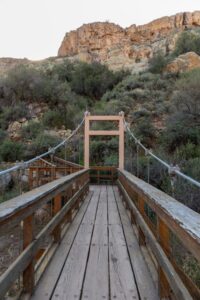


One of the most iconic features of Arizona — and a photographic favorite for its visitors — is its desert flora. From the towering saguaros that grow only in the Sonoran Desert to the many succulents and cacti that burst with gloriously colored blooms, the arid landscape’s plant life is a botanist’s and nature lover’s dream.
In fact, some of the state’s most popular attractions are its public gardens, including Desert Botanical Garden in Phoenix, Tucson Botanical Gardens and Tohono Chul, also in Tucson.
And just an hour east of the Valley, in the foothills of the Picketpost and Superstition mountains near Superior, is the country’s largest desert arboretum. Boyce Thompson Arboretum, the oldest public garden in Arizona, showcases 19,000 desert plants from the Southwest and around the world.
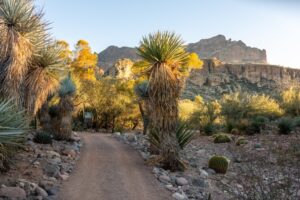


An Oasis with a Purpose
Boyce Thompson was founded in 1924 by Col. William Boyce Thompson, an engineer, financier and philanthropist who created his wealth in the mining industry. He was the founder and first president of Inspiration Consolidated Copper Co. in Globe-Miami and Magma Copper Co. in Superior.
Following trips to Russia before and after the Revolution of 1917, the New York native became concerned about his home country’s food source and developed an interest in plant research and cultivating for food.
In 1920, he established the Boyce Thompson Institute for Plant Research, now the Boyce Thompson Institute at Cornell University in Ithaca, New York, in an effort to improve agriculture, protect the environment and enhance human health.
Thompson was also enamored with Arizona’s desert landscape, and about the same time as he established the institute, he built a winter home, a 7,000-square-foot Mediterranean-style mansion called Picket Post House, overlooking Queen Creek in Superior. It was here, on hundreds of acres of mountainous terrain, that he decided to establish a desert plant research facility, and in 1924, Thompson founded his eponymous arboretum to serve as a “living museum” to the desert’s unique flora. It was incorporated as the first nonprofit institution for scientific purposes in Arizona in 1927.
Sadly, Thompson only enjoyed his desert gardens for a few years. He passed away in 1930, leaving the arboretum with little financial support following the stock market collapse of 1929. A passionate director carried on Thompson’s vision with very little funds to do so until 1964, when the property was joined by the University of Arizona, which co-managed it and reinvigorated the research program. The arboretum now partners with Arizona State University to allow student research and continue Thompson’s original mission. In 1976, BTA was listed on the National Register of Historic Places.
Today, visitors can stroll through 135 acres of gardens and view plants from the U.S., Mexico, Australia, Madagascar, India, China, Japan, Israel, South America, the Middle East, Africa, the Mediterranean and the Arabian Peninsula. In total, 3,900 taxa (species, cultivars, hybrids, varieties) are organized into 12 distinct settings, including two rose gardens, a cactus and succulents garden, a pollinator garden, a legume garden, an herb garden and a children’s garden.
The largest garden at BTA is the Australian Deserts Exhibit, which stretches over approximately 10 acres and encompasses 1,280 plantings, including the largest and most diverse stand of eucalyptus trees in North America. The centerpiece of the exhibit is Mr. Big, a red gum eucalyptus (Eucalyptus camaldulensis) that stands almost 120 feet tall. Planted in 1926 as a 3-year-old, 6-foot sapling, Mr. Big now measures more than 22 feet in diameter and is the largest known tree of its species on the continent, according to the Arizona Forest and Fire Management agency.
Another popular attraction is the Clevenger House. This historic three-room 1900s stone-and-mortar structure was the property’s original homestead. It is built into the mountainside of Queen Creek Canyon, with the rocky cliffs forming one of the home’s walls. Thompson’s grandchildren used the home as a playhouse. Kids today, on the other hand, love playing on the suspension bridge that traverses the creek and offers views of Picket Post House on the cliffs above.
The arboretum’s creekside location also provides rich riparian habitats for birds and other desert creatures.
“You’re getting interaction with wildlife when you visit here,” says Sharon Elliot, director of marketing and communications for BTA.
Javelinas, coyotes, bobcats and even gila monsters have been spotted among the greenery. On a recent January afternoon, visitors were treated to the sight of a large band of coatis that were snacking on berries in the treetops.
The arboretum is an important birding area, as well, with more than 275 different species sighted on the property, including 62 species of Special Conservation Status in Arizona. In 2007, BTA was designated as an Audubon Important Birding Area, and guided bird walks are available from October through May. Butterfly walks and evening programming that explores bats, scorpions, lizards and other nocturnal critters are also offered throughout the year.
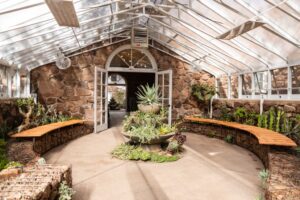


Championing Preservation
In 2020, the arboretum opened the 13-acre Wallace Desert Garden. Set within BTA’s natural desert landscape, the stunning collection of desert-friendly flora from around the world was donated in late 2014. It was part of the private garden of geneticist and philanthropist H.B. Wallace, who passed away in 2005.
Wallace, who made his fortune in egg and poultry production, began cultivating his garden after retiring to Scottsdale in 1987. He included many rare cacti and succulents from as far away as Central America, Australia, the Arabian Peninsula and Madagascar. He also set up a foundation to help ensure the preservation and safekeeping of the plants after his death, but the recession of the mid-2000s negatively affected the garden’s funding, placing the property in jeopardy.
In 2014, the foundation approached BTA with an offer: Would it accept a donation of the entire garden — more than 5,000 mature trees, shrubs, cacti and succulents?
According to the arboretum’s website, the entire endeavor was coordinated and completed by Logan Simpson Architects, Native Resources International, the Wallace Desert Gardens board and staff, and BTA. Together, the team developed and designed a natural setting that includes 1.5 miles of winding trails and a bridge over Queen Creek.
It took two years to prepare, three months to execute and two years to cultivate each piece of flora. The project included the transfer of 2,200 boxed plants, some as tall as 25 feet, as well as 4,000 smaller specimens. One hundred semitruck trips were needed to transport all of the plantings.
More than 50% (861) of the 1,223 taxa are new to the arboretum. Of the aloes, boojum trees, thorny African bushes, crested saguaros and more, 205 species are considered threatened. Sixty-two species are rare or endangered.
“The Wallace garden and the gateway emphasize how we differ from a lot of [other local botanical gardens],” Elliot says. “Seeing the collection here against the backdrop of Picketpost Mountain is just stunning. We designed the garden so that some of the trails start to wander through the base of the mountain, so it’s a neat experience.”
The main trail is also wheelchair accessible and will guide visitors in a single direction.
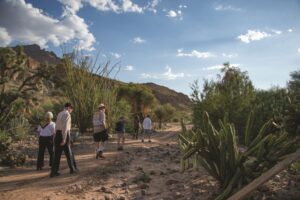


A Centennial Celebration
To commemorate its 100th anniversary, the arboretum is planning special activities and celebrations throughout the year. The festivities kicked off in September 2023 with the 100 Tree Spree, an initiative to plant 100 native trees at institutions, schools and nonprofits in the local area. In mid-January, a garden art exhibition of cactus sculptures painted by Arizona artists opened. “Shiny Splendor,” which runs through October, showcases artistic interpretations of the hedgehog cactus (Echinocereus boyce-thompsonii), which was discovered in 1926 on the property and named after Thompson.
Docent-led Legacy Tours that explore the history of BTA and Thompson’s vision are offered throughout April. And on March 24, the arboretum will host a Founder’s Celebration, a free event in honor of Thompson that will include a variety of activities for all members of the family, including live music, scavenger hunts, tasty treats and much more.
“We get comments all the time from people who’ve lived in Arizona for years and say they never knew we were here, and that’s a shame because they’ve been missing out,” Elliot says. “Not to sound cliche, but when you’re here, it feels like you’re in a Disney movie. There are birds and butterflies sweeping past you. We have beautiful views of the creek and Picketpost Mountain. The aloes start blooming in January, and February can be the start of wildflower season. There’s always something to see here.”



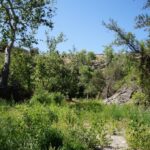
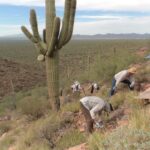


Comments by Admin